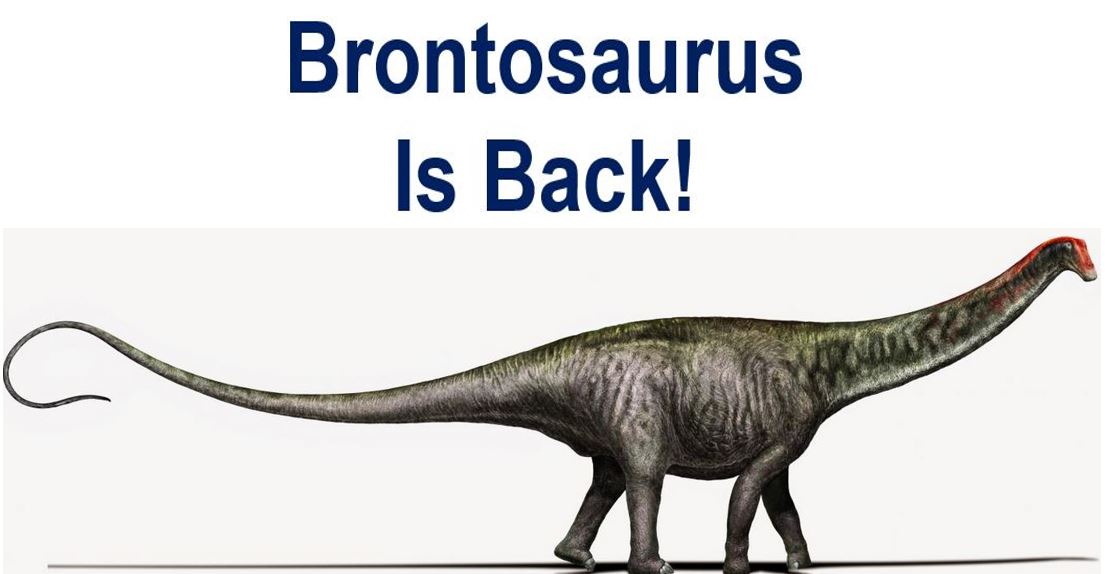Brontosaurus, the ‘Thunder Lizard’, which since 1903 was thought to have been misclassified as Apatosaurus, is a distinct genus, Portuguese, Swiss and British palaeontologists announced after revealing ‘conclusive evidence’. In other words, Brontosaurus is not only back, it had always been there.
Brontosaurus has been a children’s favourite among the dinosaurs, thanks to its evocative name and remarkable size. Ask kids to draw a dinosaur, and most of them will attempt to create a Brontosaurus.
In 1903, it was decided that the differences between Brontosaurus excelsus and Apatosaurus were so negligible that it was better to place them both in the same genus.

This is Brontosaurus as researchers see it today – with a Diplodocus-like head. (Credit: Davide Bonadonna, Milan, Italy)
Under the rules of scientific naming you go for the one that appeared first, which in this case was Apatosaurus.
After 1903, Brontosaurus was never really gone – it was simply treated as a species within the Apatosaurus genus – Apatosaurus excelsus.
Therefore, while palaeontologists thought the genus Brontosaurus was the same as Apatosaurus, they all agreed that the species excelsus was distinct form the other Apatosaurus species.
Now, palaeontologists Emanuel Tschopp and Octávio Mateus from the Universidade Nova de Lisboa, Portugal, and Roger Benson from the University of Oxford, who published their findings in the academic journal PeerJ (citation below), say Brontosaurus has always been a unique genus.
Brontosaurus – a complex history
The Western United States formed the location for dozens of new finds and fossil species in the 1870s, most notably of dinosaurs.
Field crews excavated scores of new skeletons for the famous and influential palaeontologists Othniel Charles Marsh (1831-1899) and Edward Drinker Cope (1840-1897).
During that period, Mr. Marsh’s crew discovered two huge, partial skeletons of long-necked dinosaurs and transported them to the Yale Peabody Museum in New Haven, where Mr. Marsh worked.
Mr. Marsh described the first skeleton specimen as Apatosaurus ajax, the ‘deceptive lizard’, after Ajax, the mythological Greek hero.
Two years later, he named the second skeleton specimen Brontosaurus excelsus, the ‘noble thunder lizard’.
However, as neither of the two skeletons came with a skull, Mr. Marsh reconstructed one for Brontosaurus excelsus. Brontosaurus, like Apatosaurus and another long-necked dinosaur found in the Western United States Camarasaurus, was a huge animal.
Because their skeletons looked similar, it seemed logical to recreate the Brontosaurus skull closely to that of Camarasaurus. However, it was later found that this reconstruction was wrong.
Not long after Mr. Marsh died in 1899, an excavation crew from the Field Museum of Chicago discovered another skeleton similar to both Brontosaurus excelsus and Apatosaurus ajax. The skeleton was intermediate in shape in several aspects. Therefore, palaeontologists, thinking Brontosaurus excelsus and Apatosaurus ajax were so similar, decided it would be more accurate to treat them as two different species of the same genus.
So, Brontosaurus excelsus became known as Apatosaurus excelsus, and the name Brontosaurus ceased to be considered a scientifically valid name.
In the 1970s ‘Brontosaurus’ received another humiliating blow, when scientists showed that Apatosaurus was not a close relative of Camarasaurus, but to Diplodocus, yet another dinosaur from the same area.
Diplodocus had a slender, horse-like skull. Therefore palaeontologists assumed that Apatosaurus and thus ‘Brontosaurus’ too must have had Diplodocus-like skulls rather than Camarasaurus-like skulls. That is how the popular, but incorrect myth about ‘Brontosaurus’ being an Apatosaurus with the wrong head was born.
But now, the Portuguese, Swiss and British scientists have shown compellingly – in nearly 300 pages of evidence – that Brontosaurus really was distinct from Apatosaurus – the Thunder Lizard is back!
One study overthrows more than a century of research
Emanuel Tschopp, a Swiss national who led the study during his PhD at Universidade Nova de Lisboa, Portugal, said:
“Our research would not have been possible at this level of detail 15 or more years ago. In fact, until very recently, the claim that Brontosaurus was the same as Apatosaurus was completely reasonable, based on the knowledge we had.”
In recent years, several news fossils of dinosaurs similar to Brontosaurus and Apatosaurus have been discovered, making it possible to carry out a detailed re-investigation of how different the two dinosaurs were.
In science, the distinction between species and genera is not clear cut. Does this mean that the decision to bring Brontosaurus back is simply a matter of personal preference?
Tschopp responded:
“Not at all. We tried to be as objective as possible whenever making a decision which would differentiate between species and genus.”
The scientists applied statistical approaches to calculate the differences between other species and genera of diplodocid dinosaurs, and were amazed with the result. “The differences we found between Brontosaurus and Apatosaurus were at least as numerous as the ones between other closely related genera, and much more than what you normally find between species,” explained Roger Benson.
Therefore, the three scientists have concluded that today it is possible to resurrect Brontosaurus as a genus distinct from Apatosaurus.
Professor Mateus said:
“It’s the classic example of how science works. Especially when hypotheses are based on fragmentary fossils, it is possible for new finds to overthrow years of research.”
Citation: “A specimen-level phylogenetic analysis and taxonomic revision of Diplodocidae (Dinosauria, Sauropoda),” Emanuel Tschopp, Octávio Mateus and Roger B.J. Benson. PeerJ. Published 7 April, 2015. DOI: 10.7717/peerj.857

